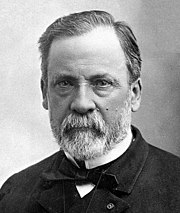LOUIS PASTEUR
| Louis Pasteur | |
 French microbiologist and chemist | |
| Born | 27 December 1822 Dole, Franche-Comté, France |
|---|---|
| Died | 28 September 1895 (aged 72) Marnes-la-Coquette, 92, France |
| Signature | |
Louis Pasteur (27 December 1822 – 28 September 1895),a French chemist and microbiologist, is best known for his remarkable breakthroughs in the causes and prevention of disease. His experiments supported the germ theory of disease, also reducing mortality from puerperal fever (childbed), and he created the first vaccine for rabies. He was best known to the general public for inventing a method to stop milk and wine from causing sickness - this process came to be called pasteurization. He is regarded as one of the three main founders of microbiology, together with Ferdinand Cohn and Robert Koch. He is also credited with dispelling the theory of spontaneous generation with his experiment employing chicken broth and a goose neck flask. He also made many discoveries in the field of chemistry, most notably the asymmetry of crystals. He is buried beneath the Institut Pasteur, an incredibly rare honor in France, where being buried in a cemetery is mandatory save for the fewer than 300 "Great Men" who are entombed in the Panthéon.












